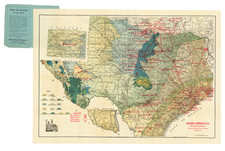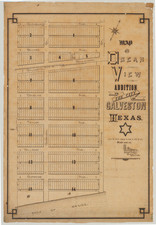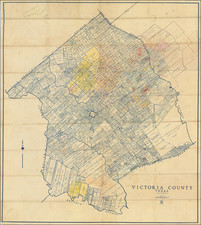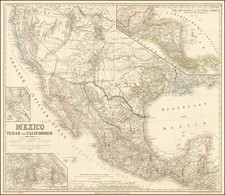Very Early Texas Land Deed Document
Issued in 1810 under Spanish Governor Manuel de Salcedo
On the Eve of the Gutiérrez-Magee Filibustering Expedition:
Landowner Required to Maintain Arms and Horses to Defend the Country Against Enemies of Spain
A Critical Moment in Texas Boderlands History
A remarkably early land sale document issued in Nacogdoches when it was still part of the Spanish province of Texas and New Philippines (la Provincia de los Texas y Nueva Filipinas). The document is an official contemporary copy, with each page properly cotejado - with a notary's manuscript rubric in the margin of each page. And while the document is not on the usual sealed paper, the text refers to this fact explaining that such paper was unavailable and thus "common" unsealed sheets of laid paper were used.
The context of the document and its contents are historically significant, given the requirement for the landowner to maintain arms and horses to defend the country, thus providing evidence that the Spanish were alive to outside threats to their control of Texas at this pivotal moment in Texas borderlands history.
Manuel de Salcedo and the Gutiérrez-Magee Filibustering Expedition
At the time of this land deed - 1810 - Nacogdoches was under the jurisdiction of the Spanish governor Manuel María de Salcedo, who served as governor of Spanish Texas until his execution in 1813 in the wake of the Gutiérrez-Magee filibustering expedition against the Spaniards in Texas. In 1812, Salcedo led a Spanish force in Texas against the self-styled Republican Army of the North, a filibustering outfit led by Bernardo Gutiérrez de la Lara and Augustus W. Magee, a West Point graduate and erstwhile U.S. Army lieutenant who resigned his commission to join with Gutiérrez, at least partly because he was not given an expected promotion in the Army. Shortly after a battle near San Antonio, Salcedo surrendered to the filibustering force. He was then marched out of town, tied to a tree, and killed. On April 17, 1813, the Republican Army drafted a declaration of independence for the state of Texas as part of the Mexican Republic, and Gutiérrez declared himself governor of the new state. The filibustering force comprised about 1400 men - Americans, Tejanos, Spanish rebels, Native Americans, and Blacks. They would eventually face total defeat by the Spaniards at the Battle of Medina on Aug. 18, 1813. Once Spanish officials recaptured San Antonio, a brutal policy of reprisal ensued, with over 300 executions. Many future fighters for Texas independence, including signers of the 1836 Declaration of Independence José Francisco Ruiz and José Antonio Navarro, fled Texas with the lesson never to trust the Spanish monarchy again.
Land Ownership Contingent on Maintaining Arms and Horses to Defend Texas Against the Enemies of Spain.
The document at hand is a deed for a town lot in Nacogdoches, including a house, owned by José Calletano de Zepeda (or José Cayetano de Zepeda). A Cayetano Zepeda is noted in the 1792 census of Nacogdoches in the Bexar Archives, described as a Spaniard, originally from the Presidio de Bexar, occupation herrero (blacksmith), age 48. And a José Ceyetano de Zepeda is mentioned in an 1826 U.S. government publication on land titles in Texas as having been the Sindico Procurador at Nacogdoches in 1795. This was a sort of trustee or attorney who handled the legal aspects of land titles in the province. In the present land deed Don Gregorio Mora served as Sindico Procurador.
The description of the land is entirely textual and includes interesting details about how posts were set in the corners of the lot, weeds cleared, and the like. According to the text of the document the owner was required to maintain arms and horses on his land, and be ready to defend the country against the insults of enemies, being always prepared to go out against them upon command. This passage in an otherwise routine land title document brings to life the realities of the sparsely populated Texas frontier at that time - whose Spanish governor was wary of "the aggressive spirit of Anglo-American frontiersmen," and who recommended that Texas welcome soldier-settlers to help maintain the Spanish crown's control of the province.
Partial transcription of the Spanish text here follows:
Señor Governador = No. 15 - José Calletano de Zepeda vecino de este Pueblo de nuestra señora del Pilar de Nacogdoches con la mayor sumicion y rendimiento ante vs. señoria comparesco con la mas bastante forma que su derecho halla lugar y al mio combenga y digo que teniendo un pedaso de tierra de ochenta y seis varas de fondo de Norte á sur lindando por el oriente con tierra [realenga?] y por el Norte con Musihn Barra calle de por medio á la orilla del arrollo que sircumbela este Pueblo en donde tengo la casa de mi mozada de frente tiene sinquenta y dos varas lindando por el poniente con Francisco del Rio callejon de por medio y por el oriente contienda realenga del cual no tengo titulo alguno de propriedad por tanto a Vs. señoria suplico se sirva mandar se me de porcion de el, en devida forma para mi mis hijos herederos y [su..?] de que recivi de merced y gracia = Nacogdoches 30 de Abril del año 180010.= José Calletano de Zepeda.
Por presentado y admitido en este papel comun a falta del sellado para al sindico procurador para que consitacion de parte y colindantes mida el expresado solar y no resultando contradicion alguna ni perjuicio de tercer pondra en posesion al intersado y fecho traigare. M. Salcedo.
Probeyolo el Sor. Don Manl. Salcedo, teniente coronel de la Infanteria de los Reales exercitos Govor. Politico y Militar de la Prova. de los Texas a los treinta dias del mes de Abril de mil ochocientos diez por ante mi de que doy fe = Manl. Delgado = escrivano de vta. Sa. En el mimso dia mez y año yo el infrascripto escrivano, notifique e hise saber á Don José Cayetano de Zepeda en su propia persona el anterior proveido, y de quedar enterado para la devida constancia lo firmo, conmigo de que doy fe = Delgado. Jose Calletano de Zepeda. Posicion=En el Pueblo de Nacogdoches á los sinco dias del mes de Mayo de mil ochocientos diez. Yo el sindico Procurado Don Gregorio Mora en consequencia y obedecimiento al decreto que hante sede de S. G, Teniente Coronel Don Manuel Salcedo y en virtud de lo que se ordena pare con los testigos de mi assistencia al solar y casa que esta parte pare y fixando las medidas por el frente de atro. solar halle que tiene de frente ochenta y seis varos rumbo al sur lina con el arroyo de la mision y para el oriente sinquenta y dos varas linda contierra. [re al-nga?] y por el Norte las mismas ochenta y seis y al Poniente sinquenta y dos varas linda con tierra de Francisco del Rio calle de por medio y no haviendo contradicion de parte de colindantes tomandolo de la mano derecha al otro Calletano Zepeda para darle porcion de la otra tierra y solar expresado le previne que a mas de cultivarla amalmerte como promete pase al cola por el referido solar hise que en cada exquina clavar poste harrancar llervas y hacer otras demostraciones de legitima y berdadera consecion la que le otorque en nombre de S.M.Q.D.G. por ante dos testigos de mi asistencia....
Auto= lista la antesediente porcion dada por el sindico procurador de este Pueblo al vecino de el Don José Cayetano de Zepeda con arreglo ... mi provido de treinte de Abrl. ultimo y sin oposision de partes: la apruevo y confirmo... como por este ... al referido Don José Calletano de Zepeda el expresado solar con las sitadas medidas a nombre de S. M. (Q.D.G.) perpetuamente para siempre jamas... para el sus hijos y desendientes...
...con las precisas condiciones de que ha de mantener Armas y caballos y estar pronto a defender el pais de los insultos de los enemigos y salir contra ellos quando se le mande y que ha de conservar en buen estado su casa y serca.
Archivere esta original y de se a la parte copia testimoniada para su resguardo = M. Salcedo.... Señ Don Manuel de Salcedo teniente coronel de Infanteria de los reales Exercitos Governador Politico y Militar por S.M. de la Prova. de los Texas Nuevas filipinas á la catorce dia del mes de Mayo de mil ochocientos diez por ante mi que doy fe = Manl. Delgado=escrivano de Vta....
Rarity
Any original document, issued at such an early date from the Texas borderlands town of Nacogdoches, is a rarity in the market. Such an intriguing land document relating to the need to shore up Spanish defenses, adds much historical interest to an inherently rare object.
Province of the Texas and New Philippines: Provincia de los Texas Nuevas Filipinas
Although less popular than the name Texas, Nuevas Filipinas remained part of the province's official name throughout the colonial period. Antonio Margil de Jesús evidently first used the name Nuevas Filipinas in a letter to the viceroy dated July 20, 1716. In it he voiced the hope that with the king's patronage it might be possible to secure "for the greater glory of God and the name of our catholic Monarch another new Philippines" among the Hasinai. Two days later the missionaries sent a representation to the viceroy in which they expressed their "great hopes that this province shall be a New Philippines." The Franciscan' intention was to equate their work in Texas under Philip V with that of their brethren in the Philippine Islands under his predecessor, Philip II, thus engendering royal support. The name did not find immediate acceptance. Neither Domingo Ramón, the missionaries, nor officials used Nuevas Filipinas in the period 1716–17. Martín de Alarcón's title as governor of Texas, issued by the viceroy in December 1716, refers only to the Province of the Texas. Nuevas Filipinas surfaces again in the address of a letter written by Fr. Isidro Félix de Espinosa from East Texas at the end of February 1718. The instructions issued on March 11, 1718, for Alarcón's expedition to reinforce Texas does, for the first time in an official document, refer to Texas as "Nuevas Filipinas, Nueva Extremadura. " In his journal of the expedition Alarcón calls himself "Governor and Lieutenant Captain General of the Provinces of Coahuila, New Kingdom of the Philippines Province of the Texas." A modification of this title appears in his memorial of services to the crown, in which he refers to himself as governor and lieutenant captain general of the Province of the Texas and New Philippines. Although Nuevas Filipinas appeared regularly on documents during the next forty years or so, if fell out of use toward the end of the eighteenth century. By the early 1800s the term could be found only in a few of the province's legal documents, particularly land grants. Census reports, orders, and other governmental correspondence general referred to the province strictly as Texas - Handbook of Texas online.
Manuel Maria de Salcedo was governor of Spanish Texas from 1808 until his 1813 execution at the hands of filibusters.
José Cayetano de Zepeda or José Calletano de Zepeda, was a resident of Nacogdoches, in Spanish Texas. He was likely a soldier in the service of the Spanish crown.











![Mapa et tierra q[u]e yos pedro Vial taigo transitau en St. Tafee este dia 18 de Octubre de La ao 1787](https://storage.googleapis.com/raremaps/img/small/3645.jpg)
![[Printed on Linen] Map of Texas and Loyal Colonies Sometimes Referred To As The United States](https://storage.googleapis.com/raremaps/img/small/93363.jpg)



